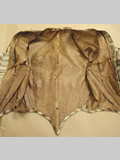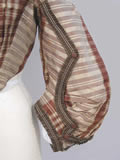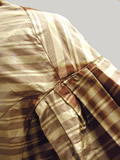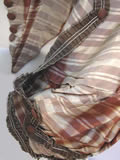This day bodice, dating from the early 1860s, is made of plaid silk paper taffeta with a solid brown glazed linen interior. The seams are machine stitched with finishing work done by hand.
Figure 1: Original Garment Front |
Figure 2: Original Garment Back |
 |
 |
Figure 3: Original Garment Interior |
 |
There are several features of this bodice that identify it with the early 1860s. In The Cut of Women’s Clothes 1600-1930, Nora Waugh explains that center front closures, the separation of bodice and skirt, and the use of bold plaid silks for day wear are common traits for women’s wear in the period of 1850-1869 (140-1). Other details frequently seen in garments of this era include dropping the armhole onto the upper arm, shifting shoulder seams back, and using curved princess seams in the back to create the illusion of a tiny waist (Payne, 512). Waugh states that the bishop sleeve first emerged in 1856 with "gathered or pleated top and bottom round the wrist" (140). Further, wide sleeves of the early 1860s grew far slimmer by the middle of the decade (Hunnisett, 86; Payne, 514). Hunnisett also writes that though deep points at center front and back of bodices was the norm throughout the Gothic Era and into the Crinoline years, this trend ended around 1866 (86).
While the interior is now very damaged, it, along with boned darts and seams, would once have been a secure base to aid in the close fitting nature of bodices of the time period. This bodice likely would have been worn with a lightly boned corset (Hunnisett, 87).
Bodice
The background of the silk is a champagne color with a series of horizontal taupe stripes and an intermittent group of vertical rust stripes. The repeat of the plaid is 1 5/8" x 9". The bodice is cut with the grain parallel to center front. It closes center front with twelve 5/8" brown covered buttons and hand-bound buttonholes that are 3/4" long and about 1" apart. The extension is only 3/8" wide. The silk is cut in three pieces: front, side back, and center back on the fold. The glazed linen is only cut with a front and a back. The front of the bodice is flatlined to the glazed linen. Center front on both sides of the body is self-faced by turning back the taffeta’s selvedge into a 1 1/4", whereas the linen’s edge is caught into the buttonholes on the right and its selvedge turns back 1 1/2" on the left side. None of the selvedges along center front have been secured to the flatlining in any way other than being caught into the buttonholes and the buttons.
Figure 4: Detail of Buttonholes& Discolored Buttons |
 |
The first dart is about 7" long with a 6 3/4" steel bone, and the second dart is about 10 1/8" long with a 9 1/4" steel bone. The bones are slipped between the silk and linen lying closest to the body and encased by 1/8" running stitches. The excess fabric on the dart interior is trimmed away and hand overcast. The side seams are pressed toward the front and finished in the same manner as the darts with a 6" steel bone.
Figure 5: Detail of Dart |
 |
The center back of both the silk and the linen are cut on the fold. However, the linen does not have a side back seam; the side back of the paper taffeta curves into the armhole. The seam allowance is folded back along the seam line and edge stitched by machine to the back piece. The shoulder seam is set back much farther than the natural shoulder, and it angles rather sharply to the back as seen in Figure 2. This causes the back to have an elegant and slimming diamond shape. The seam allowance of the shoulder seam is pressed toward the front and overcast together. There are two stacked bones at center back with a 5/8" wide casing made of the glazed linen that is whip stitched to the linen of the bodice. The longer bone measures 7 3/4" and the shorter is 5 3/4".
Figure 6: Top Stitched Side Back Seam |
Figure 7: Side Back Interior |
 |
 |
Bias pieces of the paper taffeta encase 1/16" twisted cotton cording that finishes the hem and neckline. The cording is applied to the bodice using a running stitch and is turned to the inside with a 1/4" whip stitched finish. The same cording sets off the armhole. The bottom edge of this bodice comes to deep points both at center front and center back, which suggests it is to be worn over the skirt. Another indicator is the 7 small bent wire hooks stitched intermittently along the waist so that the bodice can hook onto the skirt as seen in Figure 3. The hooks are placed at center back, both side seams, on each the second darts, and halfway between the darts and side seams.
Figure 8: Detail of Corded Hem |
 |
Sleeve
The back seam of the sleeve is straight on both sides, so it was likely cut as two pieces because the silk was not wide enough to accommodate it being cut in a single piece. The front seam is curved and has two 1/2" tucks that further exaggerate the curve. The corners along the hem and front seam are pieced on both sleeves, likely to conserve fabric, but it is covered by the decorative outer sleeve. The left under sleeve is pieced straight across a stripe about 1/3 of the way down from the armhole. There are ten tucks, varying from 1/2" to 3/4" deep, along the hem of the sleeves.
Figure 9: Detail of Sleeve Tucks |
 |
The outer sleeve is cut on the bias and caught in the front sleeve seam. The finished edge is bagged out with the linen. One point along the edge is slashed with one side pleated down to create peaks. The top portion and the edge nearest the back seam are hand stitched to the sleeve. The outer sleeve is caught into the corded hem of the sleeve, and the seam allowance of the cording acts as a 1 1/2" hand stitched facing.
The bagged out edge of the outer sleeve and the hem are finished with a brown box pleated China silk trim. It is 1 1/8" wide with edges that are machine stitched in white. The box pleats are 3/16" each and held in place with two rows of white chain stitching. The trim is unevenly basted to the sleeves with the center of the trim matching the finished edges. Each of the four peaks of the outer sleeve is finished with a covered button.
Figure 10: Detail of Trim |
 |
Damage
The interior linen is disintegrating badly, though the flatlining in the sleeves is in much better condition than that of the bodice. The exterior silk is in very good condition. There are several very small holes throughout the silk, as well as a number of bright orange spots. The orange appears to be the result of water damage because it is mostly seen as rings on the left sleeve and under the arms. Figure 4 shows discoloration of many of the buttons, and a few sections of the trim on the sleeves are disintegrating, especially along the hem.
Figure 11: Disintegrating Interior |
Figure 12: Damaged Trim |
 |
 |
© Leah Pelz, 2014





